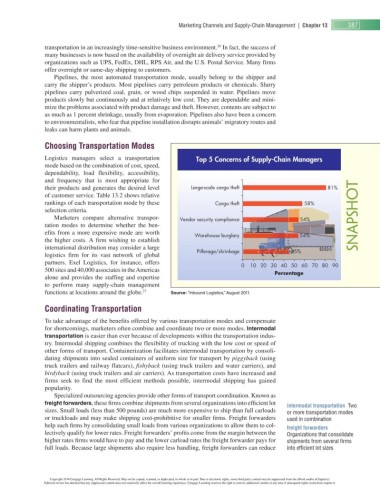Page 420 - Foundations of Marketing
P. 420
Marketing Channels and Supply-Chain Management | Chapter 13 387
26
transportation in an increasingly time-sensitive business environment. In fact, the success of
many businesses is now based on the availability of overnight air delivery service provided by
organizations such as UPS, FedEx, DHL, RPS Air, and the U.S. Postal Service. Many firms
offer overnight or same-day shipping to customers.
Pipelines, the most automated transportation mode, usually belong to the shipper and
carry the shipper’s products. Most pipelines carry petroleum products or chemicals. Slurry
pipelines carry pulverized coal, grain, or wood chips suspended in water. Pipelines move
products slowly but continuously and at relatively low cost. They are dependable and mini-
mize the problems associated with product damage and theft. However, contents are subject to
as much as 1 percent shrinkage, usually from evaporation. Pipelines also have been a concern
to environmentalists, who fear that pipeline installation disrupts animals’ migratory routes and
leaks can harm plants and animals.
Choosing Transportation Modes
Logistics managers select a transportation Top 5 Concerns of Supply-Chain Managers
mode based on the combination of cost, speed,
dependability, load flexibility, accessibility,
and frequency that is most appropriate for
their products and generates the desired level Large-scale cargo theft 81%
of customer service. Table 13.2 shows relative
rankings of each transportation mode by these Cargo theft 58%
selection criteria.
Marketers compare alternative transpor- Vendor security compliance 54% Snapshot
tation modes to determine whether the ben-
efits from a more expensive mode are worth
Warehouse burglary 54%
the higher costs. A firm wishing to establish
international distribution may consider a large
Pilferage/shrinkage 45%
logistics firm for its vast network of global
partners. Exel Logistics, for instance, offers
0 102030405060708090
500 sites and 40,000 associates in the Americas
Percentage
alone and provides the staffing and expertise
to perform many supply-chain management
27
functions at locations around the globe. Source: “Inbound Logistics,” August 2011.
Coordinating Transportation
To take advantage of the benefits offered by various transportation modes and compensate
for shortcomings, marketers often combine and coordinate two or more modes. Intermodal
transportation is easier than ever because of developments within the transportation indus-
try. Intermodal shipping combines the flexibility of trucking with the low cost or speed of
other forms of transport. Containerization facilitates intermodal transportation by consoli-
dating shipments into sealed containers of uniform size for transport by piggyback (using
truck trailers and railway flatcars), fishyback (using truck trailers and water carriers), and
birdyback (using truck trailers and air carriers). As transportation costs have increased and
firms seek to find the most efficient methods possible, intermodal shipping has gained
popularity.
Specialized outsourcing agencies provide other forms of transport coordination. Known as
freight forwarders , these fi rms combine shipments from several organizations into effi cient lot
intermodal transportation Two
sizes. Small loads (less than 500 pounds) are much more expensive to ship than full carloads or more transportation modes
or truckloads and may make shipping cost-prohibitive for smaller fi rms. Freight forwarders used in combination
help such fi rms by consolidating small loads from various organizations to allow them to col-
freight forwarders
lectively qualify for lower rates. Freight forwarders’ profi ts come from the margin between the Organizations that consolidate
higher rates fi rms would have to pay and the lower carload rates the freight forwarder pays for shipments from several firms
full loads. Because large shipments also require less handling, freight forwarders can reduce into efficient lot sizes
Copyright 2014 Cengage Learning. All Rights Reserved. May not be copied, scanned, or duplicated, in whole or in part. Due to electronic rights, some third party content may be suppressed from the eBook and/or eChapter(s).
Editorial review has deemed that any suppressed content does not materially affect the overall learning experience. Cengage Learning reserves the right to remove additional content at any time if subsequent rights restrictions require it.

